![]()
![]() This new film (great title!) looks like it will be worth a look..
This new film (great title!) looks like it will be worth a look..
Featuring interviews with Jimmy Page (Led Zep), The Edge (U2) and Jack White (White Stripes, Raconteurs, etc)
 The Ibanez Musician was born out of the Japanese copy boom of the 1970s, which also helped spawn the Ibanez Destroyer and Iceman.
The Ibanez Musician was born out of the Japanese copy boom of the 1970s, which also helped spawn the Ibanez Destroyer and Iceman.
After Ibanez were sued for copying Gibson designs they branched out into original designs. Their first original models were the aforementioned two guitars, as well as the Performer, a Les Paul-type with a small curve cut into the bass side of the neck joint.This design has been more famously used by another Japanese company, Aria, on the iconic PE series.
Around 1978 the Performer was followed by the new Studio and Musician series.
The Musician was a more conservative piece of design than the wild stylings of the Iceman and the “Explorer-on-steroids†look utilised on the Destroyer.
It had a body shape halfway between a Stratocaster and a Les Paul, the same overall shape as a double cutaway PRS, although of course those guitars came about five years later. The most basic model was the MC100, with a bolt-on neck, although all the others, up to the custom order MC550WN model (of which only 465 were made), were neck-through.
The Studio series is less well-known, and less upscale than the Musicians. The Studio series all had set necks, although this was the only main difference to the Musician.
This new series of guitars were known for their excellent sustaining properties, although this did lead to extra unwanted weight. The woods used were usually walnut and maple (for the through-neck), plus ash or walnut “wings†which formed the actual body.
Pickups were Ibanez Super 88 humbuckers, and the high-end MC500 had an onboard three-band EQ activated by a toggle switch. This gave the player free rein to create a properly unique sound, for when the other two toggle switches activating phase reversal and coil splitting of the pickups just weren’t enough.
The MC500 had controls for the passive pickup mode, and three more knobs for when the EQ switch was on. The passive controls were a master volume, master tone, three-way pickup selector and the coil split and phase reversal switches. When the third toggle switch was activated the active controls (a different knob type to avoid confusion between the passive and active controls) controlled Bass boost, Midrange boost and Treble boost. The control layout for the Musician MC500, while vast, was quite simple and easy to use.
The EQ allowed for a vast spectrum of sounds, and the beautiful woods, through-neck, carved top and huge sustain made the MC500 one of the more desirable guitars of the late 1970s. There are also many good reviews of the other guitars in the series, and the models have a cult following among players.
The guitars aren’t too rare, but can be fairly hard to find sometimes. A recent search on eBay uprooted a few guitars, mostly in America.
An MC500 is going for just under £1100, while another MC200 looks to be going for significantly less.
Every review I have read of these guitars praises them, particularly the MC500, and they are worth quite a lot now.
Below is a picture of a beautiful MC500 (albeit with no strings attached), and I will attempt to explain the control layout.

Doc Pittillo described the Saturday morning crash that has left him physically unharmed but financially devastated as something akin to a psychedelic experience.
 “I turned around and actually saw the van come through the window of the store,†Pittillo said. “It was slow motion.â€
“I turned around and actually saw the van come through the window of the store,†Pittillo said. “It was slow motion.â€
Pittillo, owner of The Guitar Doctor, 18171 Euclid St., said he was plucking a guitar in front of his shop about a minute before a minivan slammed into its front window.
“If I were standing there, my guess is I would have been killed or really badly mangled,†Pittillo said. “There are usually a lot of people in the front of the shop. Man, if that would have happened with the customers there? Somebody would have been killed…there’s no doubt in my mind. It would have been really ugly”.
Only Pittillo and one of his workers, both who were near the back, were at the store at the time.Fire officials said they received a call about 11 a.m. about a vehicle that had crashed into the store at Euclid and Newhope streets. Other details about the crash, such as the driver’s name, remain unknown because Fountain Valley Police Department officials did not return multiple calls for comment.
Witnesses said that a gold-colored minivan crashed into the shop. The driver, his wife and teen-age daughter were also in the vehicle, they added. All seemed uninjured.While Pittillo said he is grateful to be unhurt, he said he lost at about $80,000 worth of valuables inside the store, including many vintage guitars.
One in particular was a candy apple-red 1965 Fender Stratocaster, worth at least $40,000, he said. “And I have no recourse,†Pittillo said.While he had insurance on the actual building, Pittillo said the contents inside were not insured because he couldn’t afford it.
“It’s not the value so much but that this instrument I played on the road for years,â€
Pittillo said about the ‘65 Fender.
By Cindy Carcamo, Orange County Register
Interesting video this, for anyone who was ever curious about how the process of string making took place.
This video shows D’addario string manufacture.
Enjoy!
Not a guitar collecting item, but this deserves some further promotion;
“Folsom Prison Blues” performed by Wesley, 5 years old, at the 2009 Spring Coffee Shop Jam, at The Columbia City Theater in Seattle, WA.
Amazing what 5 year old kids spend their time doing these days, eh?
Rob Szupak is a semi-retired contractor itching to become a fully retired contractor. For the past three years, the 62-year-old Fairfax resident has been restoring vintage lap steel guitars and tube amplifiers and reselling them, hoping to earn enough of a living to make that his primary source of income.
Szupak’s entry into the guitar market just happened to coincide with the biggest economic downturn in decades, a recession that has sent guitar prices plummeting as much as 50 percent in some cases. Szupak is one of the 40 vendors displaying their wares at the Bay Area World Guitar Show, taking place this last weekend at the Marin Civic Center Exhibit Hall.
“It’s one of those things like sailboats, when the economy goes down, people just aren’t spending money on guitars and amps like they used to,” said Szupak, whose company is called Slide Zone. “I’ve been watching my favorite instruments in the world becoming less valuable over the years.”
Vendors throughout the exhibit hall floor said they’d reduced their prices across their inventory. Show organizer Larry Briggs said that although price cuts have hurt vendors, consumer interest remained high, even if fewer attendees were leaving with a purchased guitar in hand. He said he expected more than 1,500 attendees, on par with the same two-day event in Marin a year ago.
“It’s all coincided with people seeing the value of their home drop and their 401Ks going out the window,” said Briggs, a resident of Tulsa, Oklahoma who puts on eight guitars shows a year in the U.S., including two in Marin. “People that were making money were spending it on guitars. Now that their nest egg has been taken away in many cases, they’re not. But the opportunities to buy are certainly better now.”
“People just aren’t spending money these days,” said Gary Garcia, a Sacramento builder of handmade guitars, including one he made two years ago for former Prime Minister Tony Blair at the request of Californian Governor Arnold Schwarzenegger, who gave it to Blair as a reirement present. “They’re more likely to hold onto what they already have, so there’s a lot more repair business now.”
While the bursting of the real estate bubble certainly impacted the guitar market, many vendors said some guitars had a bubble of their own. High-end electric guitars, particularly vintage models from the 1950s and 1960s, exploded in price earlier this decade, and have subsequently taken the biggest hit. Bob Danielson of Schoenberg Guitars in Tiburon said the boom was sparked in part by a front page Wall Street Journal article 10 years ago that highlighted the value of vintage guitars as an investment.
“All of a sudden all of these novices who weren’t players or collectors started buying vintage guitars – that drove the market to insanity,” Danielson said. “You had people calling into dealers saying, ‘what’s my guitar worth today?’ They were treating it like the stock market. That really made it crazy, but it’s getting back to normal.”
For instance, a 1957 Les Paul Gibson that may have commanded $200,000 a year ago would likely fetch $150,000 today, according to Vintage Guitar magazine’s annual price guide.
The other end of the market is vastly improved, Danielson said. Entry-level guitars are cheaper and better quality than ever, and the demand remains high. To respond to that trend, Rich King, whose store, Guitar Maniacs, is based in Tacoma, Washington, took many of his guitars worth $30,000 or greater and sold them, using that revenue to buy more guitars in the $200 to $2,000 price range. “It’s all about how low will people go,” he said.
King said the Marin show is typically “softer” than other shows. While he sold 32 guitars at a show in Dallas in April, he hadn’t sold one by late afternoon Saturday. Szupak was in equally unfortunate company. He said he remains hopeful that business will pick up. “But I’m hanging onto that optimism with my fingernails right now,” he said.
Jim Welte
![]()
![]() The Washburn A10-A20V Stage series of guitars were produced between 1979 and 1985.
The Washburn A10-A20V Stage series of guitars were produced between 1979 and 1985.
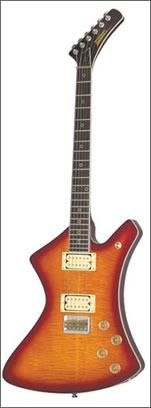 Shaped like a truncated Gibson Explorer with a chunky slanted headstock, the high quality Stage series found homes with a fair number of rock guitarists in the early 1980’s. They were produced in Japan in the highly regarded Matsumoku factory, which also built guitars for Ibanez, Westone, and a host of other manufacturers.
Shaped like a truncated Gibson Explorer with a chunky slanted headstock, the high quality Stage series found homes with a fair number of rock guitarists in the early 1980’s. They were produced in Japan in the highly regarded Matsumoku factory, which also built guitars for Ibanez, Westone, and a host of other manufacturers.
The lower model A10 has a bolt on neck, while the higher priced A15 had a set neck, leading up to the top of the range A20s which had through necks.
Washburn also made a bass version, the B20 which sells for around the same prices as the guitars.
Washburn released them again as a re-issue in 1995. Prices are fairly low for such a well made guitar, but I guess the shape is an acquired taste, not suitable for everyone.
I have recently seen a couple of A10s for sale on GBase for $5-700, so I have to assume that the A20 will be a little higher, probably $800-1000, which I think makes them pretty decent value.
![]()
![]() This guitar was originally made from 1982 to 1984 in Japan by Tokai, who at this point were looking to expand away from the copies they specialised in.
This guitar was originally made from 1982 to 1984 in Japan by Tokai, who at this point were looking to expand away from the copies they specialised in.
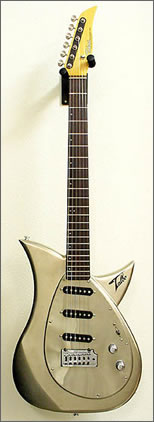 It was very unusual in that the body was not made of wood, as you might expect, but aluminium instead. As such the name was actually an acronym for Tokai ALuminium BOdy. The benefits of using aluminium were sustainability- no trees get chopped down to make enough aluminium for a Talbo body, and a different sound.
It was very unusual in that the body was not made of wood, as you might expect, but aluminium instead. As such the name was actually an acronym for Tokai ALuminium BOdy. The benefits of using aluminium were sustainability- no trees get chopped down to make enough aluminium for a Talbo body, and a different sound.
Made of cast aluminum alloy AC-4B, which is commonly used in racing car engines, the Talbo’s design is simple and elegant, combining new and traditional elements. Basically, it’s like two superimposed teardrops with the tips pointing right and left to yield a bi-level, sculptured double cutaway. Its headstock decal reads “The New Legend Of The Guitar History.”
The aluminium body was mostly solid, but with a large hollow chamber for the controls and for weight reduction. It had Blazing Fire pickups, usually a bridge humbucker and two single coils although two humbucker versions are not uncommon. The neck is made of maple and is bolted to the body.
The Talbo Blazing Fire is a quality guitar, comfortable, easy to play, with a great sound. If there’s a limitation, it’s that the three-way select limits the tonal potential, although this is mitigated somewhat with the two volumes. Perhaps the most famous appearance of the Tokai Talbo in the 1980s was in the hands of the band Devo.
Tokai Talbos were promoted briefly in American and European markets for perhaps a couple years, but after 1984 seemed to disappear from the radar. They didn’t disappear  though. The Talbo appears to have continued in production in Japan since its ’82 debut. And what’s more, it continued to evolve. What had been called the Blazing Fire became simply the Talbo, in its present state offered with twin humbuckers. In 1999, Tokai introduced the Talbo Woody, an all-wood version made of two hollowed-out pieces of maple.
A more interesting variant was the Talbo Junior that debuted in 2000. It takes the teardrop-shaped sound chamber and encapsulates it in cast aluminum, then hollows the top of the body and cutaway horns, making them just a frame. Then, to spice things up, it adds a built-in amplifier under the strings. That same year, the Talbo’s body was extended and turned into the Talbo Bass. And finally, Tokai brought back the Blazing Fire moniker on a fantastic blue-tinted transparent plexiglass version, still with the 3-D Talbo shape, but with no aluminum. These are produced in Korea.
So what of the original Talbo? Well, prices probably are about £700-£1000 for the guitars and basses, while the new Woody models are probably significantly less.
You have probably seen this story by now, but I thought I’d report on it anyway;
A broken guitar is turning out to be a major break for Canadian musician Dave Carroll.
Carroll has become an Internet sensation after posting a revenge song on YouTube about United Airlines’ baggage handlers breaking his guitar during a flight in the United States.
His video for the song “United Breaks Guitars” was posted on the popular file-sharing site Monday night and had received more than 600,000 hits by Thursday evening.
 He’s also received thousands of emails and a flood of friend requests on Facebook.
He’s also received thousands of emails and a flood of friend requests on Facebook.
“I was thinking I’d definitely get some action on (YouTube) because the song has been resonating so well with audiences as I’ve been performing it, but I didn’t know it would take off like this,” Carroll said Thursday.
“It’s been a whirlwind and the craziest two days of my life.”
On the same day as Michael Jackson’s memorial service Tuesday, Carroll’s video was one of the most watched on YouTube.
Carroll, 41, said it’s ironic that his video has gotten far more attention than anything he’s ever done in 15 years as a musician.
“Every musician wants to get their stuff out there. I just didn’t necessarily expect it to happen in this way.”
Carroll, a guitarist for the pop-rock group Sons of Maxwell, might have to scrap plans to take it easy this summer as he fields calls for appearances.
Since the clip appeared on The Chronicle Herald’s website Tuesday afternoon, Carroll’s schedule has been packed with interviews. On Wednesday night, the story was featured on the Situation Room on CNN and has appeared in newspapers across Canada and the U.S. Even Oprah’s people called Thursday afternoon.
Along with emailed stories from people who empathize with his broken guitar and damaged luggage, Carroll has received a stream of requests for gigs from as far away as Las Vegas.
The catchy song recounts Carroll’s year-long struggle to get compensation for what he calls “a vicious act of malice” at O’Hare International Airport in Chicago last year.
Carroll was flying between Halifax and Nebraska when he switched planes in Chicago. The passenger next to him noticed baggage handlers tossing guitar cases outside the plane.
At first Carroll thought his Taylor guitar was destroyed. Even after paying $1,400 in repairs, it still doesn’t play the way it used to but he keeps it for sentimental reasons. He played it on all eight of his band’s albums.
The songwriter spent the past year trying to get compensation from United Airlines. When the airline refused to take responsibility, the songwriter made the humorous music video and posted it online.
Some fans have praised Carroll in emails for dealing with the problem in what they say is a distinctly Canadian way.
“They appreciate the high road that I’ve taken with the light-hearted approach to it and they say they’re proud to be Canadian because of it,” said Carroll.
Taylor Guitars in California got in touch to say they’d be happy to see if they could repair the damaged guitar. They also promised a big discount on his next purchase.
United Airlines also called to say it wants to discuss the situation. Officials for the airline reportedly said they liked the video and want to use it as a textbook case on how to handle customer complaints in the future.
The video was shot in 12 hours with friends dressing up as flight attendants and musicians. Volunteer firemen played the baggage handlers who are shown playing catch with the guitar case and tossing it like a hammer throw.
Carroll initially told United he would write three songs about his broken guitar. He plans to debut the second song in the next few weeks but hasn’t written the third one yet.
He said it remains to be seen whether his story will be “a love story or a tragedy.”
By ELIZABETH McMILLAN The Canadian Press
![]()
![]() A 1958 Hofner Senator guitar owned by John Lennon sold for £205,250 at Christies London auction yesterday.
A 1958 Hofner Senator guitar owned by John Lennon sold for £205,250 at Christies London auction yesterday.
Guitars owned by John Lennon very rarely appear on the market and George Harrison’s verification of this guitars’ provenance in his letter to Lily Evans is invaluable.
Harrison’s own keen interest in guitars meant that he had a clear recollection of the models he and his fellow Beatles owned and used over the years. In the course of Christie’s research, Lennon’s friend and colleague Pete Shotton told us that although he himself didn’t remember who played what guitar [Shotton himself was not a guitarist but played the washboard in the Quarry Men] George had an extremely good memory for detail and would not put his name to a statement unless it was correct.
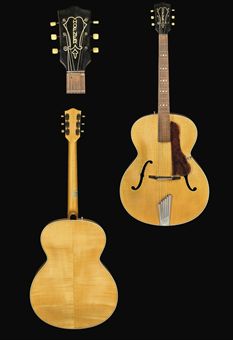 There has been some written speculation in the past that this Hofner Senator may be the very one that former Quarry Man Ken Brown owned, however this seems unfeasible when the provenance of this guitar is analysed.
There has been some written speculation in the past that this Hofner Senator may be the very one that former Quarry Man Ken Brown owned, however this seems unfeasible when the provenance of this guitar is analysed.
In the course of their research Christies spoke to Ken Brown himself about this rumour and he stated that he did not believe this to be the same guitar as the Hofner Sentator he owned. Also when it is considered that fellow Beatle George Harrison recalls Lennon owning one of these models, and that this guitar’s history shows that John gave his Hofner Senator and a white Vox guitar to trusted friend and road manager Mal Evans.
Evans did not appear on the Beatle scene until 1963 long after Ken Brown’s six-week interlude with the Quarry Men in 1959, and as far as we know their paths never crossed. All these factors appear to refute the Ken Brown association with this particular guitar entirely.
In the late ’50s and early ’60s American electric guitars were not readily available in the UK and if they could be found were very expensive, as a result budding guitarists had to rely on German-made and European electric guitars. Although Lennon came to be identified with the Rickenbacker 325 from late 1960-1961 onwards, what he himself described as his first ‘real guitar’ was a Hofner.
As soon as John Lennon and George Harrison began to earn some money by playing at the Casbah club in Liverpool with the Quarry Men, they both purchased Hofner Club 40 electric guitars, John’s first Hofner, and George’s second, his first being a Hofner President. John’s guitar was acquired via hire-purchase from Hessy’s Music Shop on August 28th, 1959 and he recalled in an interview that when ..George and I saw a Hofner Club 40 we thought it was the end. All the Quarry Men’s performances in 1959 at the Casbah Coffee club were without a drummer – if they were asked about this absence, they would respond:Â “The rhythm’s in the guitars”. The line-up of guitars at this time was John and George with their two Hofner Club 40s; Ken Brown with his Hofner Senator [for the 6 weeks he was with the Quarry Men] and Paul McCartney with his Zenith.
Hofners are closely associated with all the early Beatles, although in November 1959 George Harrison had moved on from his Hofner Club 40 to a Futurama, the closest thing he could get to a Fender Stratocaster. In January 1960 when Stuart Sutcliffe joined the group as bass player he purchased a large electric Hofner 333 bass guitar with money he had received from selling one of his canvases at the Walker Art Gallery in Liverpool. With the addition of Sutcliffe the group’s name changed from the Quarry Men to The Beatles [as a tribute to Buddy Holly’s Crickets although initially spelt Beatals]. Photographs of the group during their landmark first tour of Hamburg show Lennon playing his Hofner Club 40. It was this gruelling tour which provided the group with the foundation for their success, as Mark Lewisohn wrote:Â Five hundred hours on stage in Hamburg…forged the style that would conquer the world. It seems highly probable that Lennon may have purchased this Hofner Senator whilst earning money in Germany either in 1960 or the following year. It was there in Hamburg in 1961 that Paul McCartney acquired what was to become his signature instrument, his first Hofner 500/1 violin bass.
The lack of photographic evidence of Lennon with this Hofner Senator suggests that he probably kept this guitar at home for writing purposes. It is significant that John Lennon had this guitar during those formative years in the early sixties, and that it was with him right at the beginning of his phenomenal career, when he was writing such early classics as: Please Please Me – The Beatles first No 1; Do You Want to Know A Secret, There’s A Place, I Feel Fine, Help!and Ticket To Ride to name but a few. Putting speculation aside for a moment, it is certainly true that John Lennon guitars with provenance are exceptionally rare and to see one from Lennon’s early career supported by documentation from fellow Beatle George Harrison is scarce indeed.
Serial No.4697, Senator model, natural finish, 22 fret fingerboard with five triple dot inlays, back of the neck applied with a square paper sticker the blue background with cream lettering spelling LOVE; Compensator tailpiece, bound f-holes, plastic facia with a Hofner logo, simulated tortoiseshell pickguard; and contour case containing a few pieces including a contemporary set of Martin Bronze strings, and a simulated tortoiseshell guitar pick; accompanied by: a facsimile copy of a typescript letter from George Harrison to Mal Evans’ widow Lily on October 26th, 1982 on Harrisongs Ltd. headed stationery, regarding this guitar which states that this: Hofner is one of the first guitars of John’s going back to the early days in Liverpool (1960-ish)… ; and a photograph of Lennon playing a Hofner Club 40 at the Top Ten Club, Hamburg, 1960 —8x10in.(20x26c.) (printed later).
Two Hofner Violin basses, both signed by Paul McCartney, were also sold in the same auction; a 1960’s one sold for £8750 and a 1970’s model for £10, 625.
![]()
![]() Michael Jackson isn’t the name that usually springs to mind when thinking about guitars, although Eddie Van Halen and Steve Lukather played on the “Thriller” album, Slash played on “Black and White”, and I think Steve Stevens played on “Dirty Diana”.
Michael Jackson isn’t the name that usually springs to mind when thinking about guitars, although Eddie Van Halen and Steve Lukather played on the “Thriller” album, Slash played on “Black and White”, and I think Steve Stevens played on “Dirty Diana”.
As the world and his wife are still going on about his death, I thought this video would be a fitting tribute to his passing; it has all the elements required for a fitting tribute…guitars, Billie Jean, young boys…
This kid is an incredible player..Enjoy!
RIP Michael..
![]()
![]() We made a trip to the London Guitar show last weekend, or to give it its proper title, the London International Music Fair 09, held at the Excel Centre in East London.
We made a trip to the London Guitar show last weekend, or to give it its proper title, the London International Music Fair 09, held at the Excel Centre in East London.
I have to say it was a disappointment.
There were noticably fewer guitar manufacturers on display; no Fender, Gibson, or Dean and very few bass companies either, compared to last year.
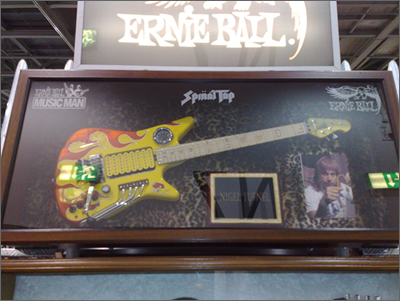
Ernie Ball/Musicman has the same display cases from the last show with the Spinal Tap Nigel Tufnell  “show guitars”  from the last show, as well as autographed Steve Lukather and Albert Lee models.
Acoustic makers were well represented, with quite a few small manufacturers taking stands, and a few companies selling accessories and peripherals.
Apart from a few other notable amp and guitar companies such as Orange, Marshall (with Jim Marshall signing autographs!) Yamaha, PRS and Vintage/Fret King/JHS the rest of the show seemed to be full of PA gear and MIDI stuff.
I assume the credit crunch had an effect on the number of companies able to commit to taking stand space this year, and also there appeared to be less people milling about too.
I guess people don’t have the same levels of disposable income they used to, or if they do, they are being more reticent about parting with it.
Overall it felt disappointing, although I’m sure we’ll be there complaining again next year!
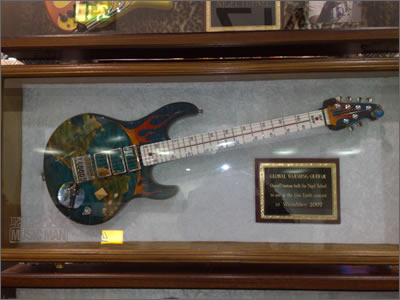
I found an interesting new website today, which may be useful for all of us at some point.
 The Parts Drawer is a vintage guitar parts service, dealing primarily with Gibson and Fender (about 80% of their stock) but also catering for other makes too.
The Parts Drawer is a vintage guitar parts service, dealing primarily with Gibson and Fender (about 80% of their stock) but also catering for other makes too.
In their own words;
With over 20 years of experience in the business we offer an expertise that is unrivaled in the vintage guitar parts industry.
The Partsdrawer our flagship Internet store has a constant changing inventory and is updated daily. We guarantee all parts that we sell are authentic and not reproduction.
Over the years we have had the opportunity to buy and sell thousands of vintage guitars and have noted every detail of their original parts.
We have seen just about every variation of vintage guitars and hundreds of custom ordered vintage guitars from Gibson, Fender, Gretsch, Martin, National , Guild and many others from original owners that have has unique but original parts to them.
Vintage Gibson guitar parts and vintage Fender guitar parts make up 80% of our inventory but we carry all vintage brand guitar parts when possible. If we do not have the part you need in stock at the moment we will gladly try and track it down for you .
We have been a part of the vintage guitar community for over 20 years and has made critical connections over the years that enables us to offer the largest selection of vintage guitar parts in the country. We also have an endless supply of vintage guitar parts from our customer base throughout the world.
Many of our customers sell us parts , broken guitars , new old stock parts  from music stores and even trade in parts for our vintage guitar on a daily basis. This makes our business both exciting and interesting because we never know what will walk through our doors today.
Please take a moment and browse our site and view the fine selection we have at the moment . There is never a problem. The Partsdrawer offers a no questions asked 48 hour return privilege . A quick search on the Internet and the associated guitar forums and you will find our reputation is outstanding as is our commitment to our customers is unsurpassed.
Link is here; The Parts Drawer
![]()
![]() Fender’s iconic Telecaster has many submodels to its name, which have their own distinct set of players. These include the Thinline semi-hollow model, the Custom with a humbucker at the neck and a different scratchplate, and the Deluxe, with two humbuckers and a wide headstock reminiscent of the 1970s Stratocasters.
Fender’s iconic Telecaster has many submodels to its name, which have their own distinct set of players. These include the Thinline semi-hollow model, the Custom with a humbucker at the neck and a different scratchplate, and the Deluxe, with two humbuckers and a wide headstock reminiscent of the 1970s Stratocasters.
But that isn’t the full list of submodels offered as part of this iconic range…
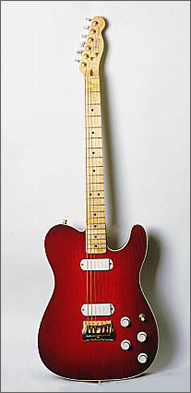 The Elite concept was an ambitious project to combine tradition with modern (at the time) technologies with more user-friendly hardware, upgraded electronics and better neck adjustment. The intention was to produce an upgraded version of a classic with a more modern look and feel, and to hopefully entice some Gibson players into the Fender family.
The Elite concept was an ambitious project to combine tradition with modern (at the time) technologies with more user-friendly hardware, upgraded electronics and better neck adjustment. The intention was to produce an upgraded version of a classic with a more modern look and feel, and to hopefully entice some Gibson players into the Fender family.
It was designed as a loud rock-orientated instrument, with 2 humbuckers, four knobs as opposed to the usual two,a three way toggle switch and white binding on the top body edge. The Elite had new pickups and active circuitry, with MDX and TBX controls, a biflex truss rod and a new heavy duty cast bridge, not usually seen on Telecasters. According to several reviews on Harmony Central.com the guitar has a heavy ash body and the usual bolt-on maple neck.
The Telecaster Elite is truly “the one that got awayâ€- it was introduced in 1983 in 3 different versions;
A tremolo and 22 fret neck version were also considered, but CBS’s decision in 1984 to divest from Fender put paid to these variations.
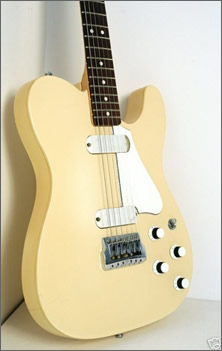
It was, as was the case with the Performer and Katana released around the same time, just too different for traditional Fender players to accept as a guitar truly worth their attention and was dropped with little or no fanfare in 1985.
However, if we assess it on its own merits the story could have been quite different.
The guitars weren’t generally accepted by Fender fans, and as such are rare. However, examples occasionally come up for sale, usually in the £750-1200 range. I myself saw one on a recent trip to that haven for all things guitar, Denmark Street in London. The price tag said £ask, however, so prices remain unclear.
![]()
![]() The Dan Armstrong Plexiglass was a very odd guitar originally made from 1969 to 1971 as an effort by popular amplification company Ampeg to draw in some more sales than their then-ailing amp lines were. The guitars came about from legendary guitar builder and repairer Dan Armstrong posing Ampeg the question:
The Dan Armstrong Plexiglass was a very odd guitar originally made from 1969 to 1971 as an effort by popular amplification company Ampeg to draw in some more sales than their then-ailing amp lines were. The guitars came about from legendary guitar builder and repairer Dan Armstrong posing Ampeg the question:
“Since you make guitar and bass amplifiers, why not also make guitars and basses?â€
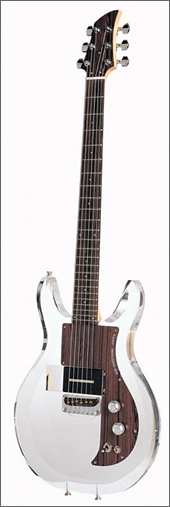 Ampeg then asked Armstrong to design some guitars and basses for them to market. The design he came up with resides somewhere between a Strat and an SG, but with a surreal twist: the body was made entirely of a solid slab of Plexiglas (the trade name for a type of rigid, clear plastic) and the scratchplate of a piece of the wood-grain replica pattern Formica, popular on furniture in the 1960s and 70s.
Ampeg then asked Armstrong to design some guitars and basses for them to market. The design he came up with resides somewhere between a Strat and an SG, but with a surreal twist: the body was made entirely of a solid slab of Plexiglas (the trade name for a type of rigid, clear plastic) and the scratchplate of a piece of the wood-grain replica pattern Formica, popular on furniture in the 1960s and 70s.
The other very novel and inventive feature of the Dan Armstrong was the electrics arrangement. There was only one pickup “slotâ€, at the bridge position. There was no pickup actually installed, but specially designed self-contained pickups were available, a twin blade humbucker or a blade single-coil. All the pickups were contained in the same size casing, but the upside was that the two types of pickups could be slotted in very easily and with no complex modification required. There was also an inbuilt volume boost circuit.
There were a couple of clear upsides of the Plexiglas Ampeg, which was available as a guitar or bass. The solid Plexiglas body had a lot more sustain than most other guitars available at the time, new pickups could be slotted in easily with the radical circuitry, and the Plexi body just looked refreshingly different. However, it was also very heavy, and more difficult to make than wooden guitars. Ampeg and Dan Armstrong parted ways in 1971, and the guitar was no more. However, the model has been reissued and is currently available. Ampeg also do cheaper versions made of mahogany or swamp ash.
The guitars have been most famously used by Dave Grohl of the Foo Fighters and Keith Richards of the Rolling Stones.
Current prices for originals are high, and the 1970s models are rare. The armies of 1970s Ampeg copies by Ibanez and Shaftesbury are also rare and collectable, but prices for the reissue start at £450-ish for the wooden ones, and the Plexi reissues are about £1000.
![]()
![]() Now here’s one you might not have heard of.
Now here’s one you might not have heard of.
Daion were an old Japanese company operating from the famed Matsumoku factory for a short period in the early 1980s. The Daions were very high quality, and full of innovative features.
They had a range of electrics, basses and acoustics which were often very different to the usual guitars available from the bigger companies.
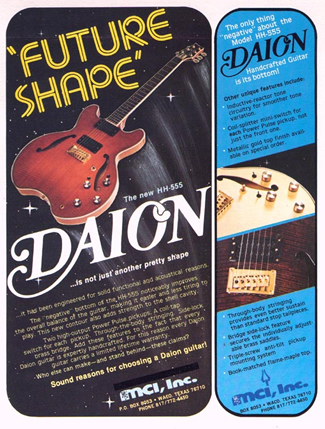 One of the better known (and I use that term loosely) Daion models was the semi-solid ES-335-alike 555 Headhunter, which featured an innovative third cutaway on the bottom of the body.
One of the better known (and I use that term loosely) Daion models was the semi-solid ES-335-alike 555 Headhunter, which featured an innovative third cutaway on the bottom of the body.
The central solid block was a sandwich of maple and spruce, with ten grooves cut into each end for increased resonance. It also included a coil split function for each pickup and through-body stringing, a first for semi-hollow guitars.
The company also made two lines of solid-body twin cutaway guitars. The Savage utilised a bolt-on neck and two humbuckers, or three in the case of the Barbarian from the same line.
There was also a bass, similar in looks to a Gibson Ripper. The other run was the through-neck Power series.
This had the SG-alike Power Mk.X and the Mk.XX, which looked similar to a Westone or Ibanez Musician. These also had two humbuckers.
Daion also made acoustic guitars, some, in the Caribou and Gazelle series, with a similar bottom cutaway to the 555 Headhunter. There were even 12 string models.
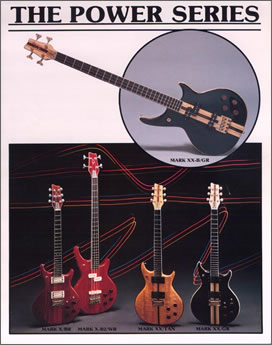
The Caribou and Gazelle were Daion’s response to the upcoming amplified acoustics market, while the Legacy and Year series were standard high quality acoustics.
Daion, for whatever reason, was a shortlived brand which never really took off.
Very few people have ever even heard of this underrated company, which is why, in the rare event of a Daion of any type coming up for sale, it never generates as much interest as it probably should.
Daions sell infrequently, so prices are unclear. I found a Daion Acoustic which sold for $850 a couple of years back, but Ebay searches didn’t bring up any guitars at all. I would guess the 555 semis would be worth between £500-1000 and  if the trickle of enthusiastic players is to be believed they are worth every penny of whatever figure they sell for.
![]()
![]() In a downer moment that must have left countless concert-goers blinking, shaking their heads, and bellowing, “drag, man!” Guitarist Ronnie Montrose actually stopped a show in mid-song, had the house lights turned on, and scoured the theater when his 1959 Gibson Les Paul Standard was stolen right off the stage.
In a downer moment that must have left countless concert-goers blinking, shaking their heads, and bellowing, “drag, man!” Guitarist Ronnie Montrose actually stopped a show in mid-song, had the house lights turned on, and scoured the theater when his 1959 Gibson Les Paul Standard was stolen right off the stage.
 Montrose, a San Franciscan, hasn’t seen his guitar (which he bought from J. Geils) since that night on Oct. 10, 1972 when he played Dudley, Mass. with the Edgar Winter Band … until now. The San Francisco musician — who has played with Herbie Hancock, Van Morrison and others — claims that after 37 years of scouring and thousands of dollars spent on private detectives, his guitar has turned up in the possession of British musician and guitar collector Gary Moore — and, last week,  Montrose filed suit in San Francisco District Court.
Montrose, a San Franciscan, hasn’t seen his guitar (which he bought from J. Geils) since that night on Oct. 10, 1972 when he played Dudley, Mass. with the Edgar Winter Band … until now. The San Francisco musician — who has played with Herbie Hancock, Van Morrison and others — claims that after 37 years of scouring and thousands of dollars spent on private detectives, his guitar has turned up in the possession of British musician and guitar collector Gary Moore — and, last week,  Montrose filed suit in San Francisco District Court.
Gibson Les Paul models of this vintage are crafted of mahogany; only around 1,700 or so were ever made and no two guitars look exactly alike. Montrose claims he can identify his old axe from pictures of Moore’s collection — but, more exactingly, he says the serial number of the guitar is the same as the one taken from him in Dudley. Â Â
Reached at his home in Brighton, England, Moore refused to discuss the matter, saying only that the “whole thing is a sham†and “I’ve had that guitar for more than 20 years.†Montrose doesn’t dispute that notion, but he insists that doesn’t change the fact that Moore is in possession of his stolen guitar and must return it. An angry Moore refused to comment further on his tussle with Montrose over the decades-old instrument.
The legal ramifications of the case are complex, and Montrose hopes to get a judge to weigh in on several issues, including the statute of limitations on a 37-year-old case and an instance in which the current owner of a piece of stolen property is not alleged to have stolen it. Another major issue is jurisdictional, as the theft is alleged to have occurred in Massachusetts, its current owner lives in England and Montrose lives in San Francisco.
Ed Roman, owner of Ed Roman Guitars in Las Vegas, has served as an expert witness in stolen guitar cases for the estate of late guitar great Jimi Hendrix. He said Montrose faces an uphill battle, primarily because the alleged theft occurred so long ago.
Roman said the Hendrix estate and Paul McCartney have been unable to retrieve stolen guitars in cases where they knew who had them but were unable to overcome the years gone by. “If it is more than 10 years ago, the person who has it usually keeps it,” he said. “I doubt Ronnie is going to be able to get it back.”
Guitar thefts have long been common in the music business. R.E.M.’s Peter Buck had his prized Rickenbacker guitar stolen in September in Helsinki, Finland, only to have it returned anonymously two weeks later at a show in Luxembourg. Slash of Guns N’ Roses fame had his Gibson Les Paul Goldtop guitar stolen from his studio in 1998, and Gibson eventually made a new one for its longtime star client.
Montrose’s hunt for his guitar has been rife with false leads, missed opportunities and dead ends. In January 1977, someone contacted one of Montrose’s bandmates about the guitar’s whereabouts, only to disappear when Montrose hired a private investigator to look into it.
The hunt regained steam in the early 2000s when Indelicato was given a photo of a 1959 Gibson Les Paul by another guitar dealer at a Texas guitar show and told that Montrose’s instrument was in the hands of an English guitar player. The photo showed the guitar’s serial number, and Indelicato claims that an Internet search for the serial number sent him to a forum thread on the Gibson Web site that connected Moore and the serial number for Montrose’s missing guitar.
But it was the November 2007 issue of the British magazine Guitar Buyer that ignited the standoff between Montrose and Moore, who once played for Thin Lizzy as well as being a well respected solo artist.
The publication featured a multi-page spread on Moore and his guitar collection, including several photos of a 1959 Gibson Les Paul Standard. The Sunburst guitar is known for its distinctive maple wood face with unique wood grain patterns. Montrose claims a photo showing a pin-sized hole in the back of the guitar is the proof, as he drills such holes in all of his guitars.
The Guitar Buyer photos showed that the guitar had sustained significant wear and tear over the past 37 years, a sign that Montrose’s complaint claims “substantiates a risk of future damage so as long as the ’59 Gibson remains in Mr. Moore’s possession.”
An angry Moore refused to comment further on his tussle with Montrose over the decades-old instrument. But his quote in the Guitar Buyer story shed light on its value to both men.
When asked if he still played the ’59 Gibson on the road, he replied, “Sometimes, but don’t tell anyone that. I don’t really like taking it out too much because it’s getting a bit scary now. I don’t think I’ll find another Gibson Les Paul to replace it. I’d have to get one of the same vintage, because no matter what new ones I get, they’re never going to be like that.”
![]()
![]() Blues/Jazz guitarist Robben Ford merges styles to redefine the term “fusion†music. His sound, delivery and conception are all his own – as unmistakable and personal as a fingerprint. He chose a deliberate reinterpretation of the unusual Fender Esprit Ultra as the basis for his signature instrument (the Fender Robben Ford Signature model), which reflects Robben’s discriminating and diverse as both a soloist and rhythm player.
Blues/Jazz guitarist Robben Ford merges styles to redefine the term “fusion†music. His sound, delivery and conception are all his own – as unmistakable and personal as a fingerprint. He chose a deliberate reinterpretation of the unusual Fender Esprit Ultra as the basis for his signature instrument (the Fender Robben Ford Signature model), which reflects Robben’s discriminating and diverse as both a soloist and rhythm player.
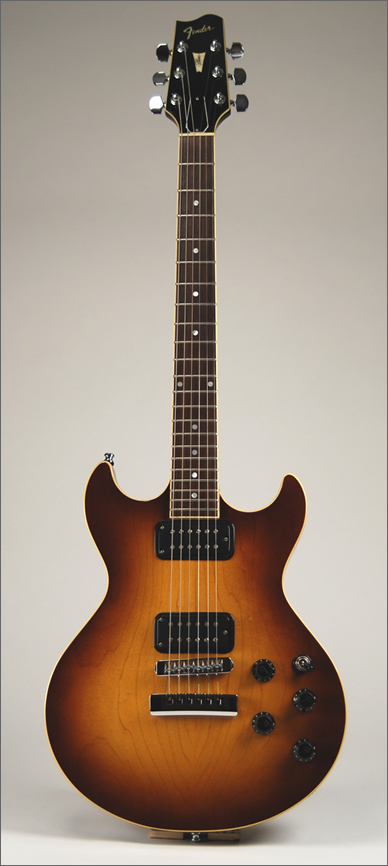 Designed in the mid-1980’s, the Esprit effectively reconciled the differences between a blues, jazz and rock guitar, making it ideal for Robben’s varied musical tangents. He was originally drawn to the smaller body size, double-cutaway comfort and remarkable playability of the Esprit as an alternative to the larger, honky-sounding semi-hollow-body he had been playing. Though the Esprit was discontinued by the late 1980’s, Robben remained an ardent user.
Designed in the mid-1980’s, the Esprit effectively reconciled the differences between a blues, jazz and rock guitar, making it ideal for Robben’s varied musical tangents. He was originally drawn to the smaller body size, double-cutaway comfort and remarkable playability of the Esprit as an alternative to the larger, honky-sounding semi-hollow-body he had been playing. Though the Esprit was discontinued by the late 1980’s, Robben remained an ardent user.
The History of the “Master Series” Â (by Gary Koehler) is as follows;
Approximately 25 years ago, Dan Smith had an idea. He conceptualized a solidbody guitar with routed chambers. These chambers would, in theory, provide a more resonant tonal characteristic. He also formulated and designed a basic shape for the guitar.
Then, in the early 1980s, Fender became interested in producing and marketing instruments which would be viewed as alternatives to those offered by Gibson. These guitars would not be copies, of course, but highly playable guitars with versatile electronics and other features previously unavailable on instruments manufactured by Fender. The company asked Smith to submit a concept, and what followed was an adventurous effort to produce a new line of guitars unique to the Fender’s catalog. The line was called the Master Series.
Two of Smith’s designs were solidified – the Flame and the Esprit (pronounced espree). Both featured alder bodies with routed tone chambers, maple tops, and set-in necks.
The Flame’s body is slightly larger than a Gibson Les Paul, and features two slightly offset cutaways, similar to Gibson’s SG. Two special-design humbucking pickups were developed via Schaller, as was a tailpiece with fine-tuners. The intention was to offer an electronically versatile alternative to the Gibson Les Paul.
The Esprit’s body is slightly larger than the Flame’s, and features two symmetrical cutaways. As with the Flame, two special-design Schaller humbuckers were employed in conjunction with the fine-tuning tailpiece. This instrument was intended as an alternative to the Gibson ES-335.
A third model was an archtop designed by the late James D’Aquisto. His design included some imaginative, versatile features and stands as a testament to D’Aquisto’s creativity as a luthier.Â
These three designs were marketed together as the Fender Master Series.
Once designs were approved, the company turned its attention to issues of manufacturing and production. Fender decided that, at that time, it did not possess the technology to build the instruments. The Japanese company Fujigen Gakki (which served as an Ibanez facility) was contracted by Fender to manufacture the line.
Fender ultimately decided to produce three models of both types. The suffixes Standard, Elite, and Ultra were added under the headings Flame and Esprit. Standards featured dot inlays and chrome tuners. The Elites featured diamond-flake inlays and pearloid-button tuners. And the Ultras had split-block shell inlays, ebony-button tuners and gold hardware. Finish options on the Standards were limited to black, autumn sunburst, and cherry sunburst. The Elite and Ultra were also available in white or pink frost, and candy red or candy green metallic burst.
Smith said Fender offered the Kahler tremolo bridge as an option on these guitars. He recalls Fender made the modification post-production, and relatively few were shipped.
He was unable to find records indicating quantities made, but estimated that between late 1983 and 1985, a few thousand were manufactured. In retrospect, Smith feels the guitars were successful in regard to quality and public perception. The line’s downfall was the sale and subsequent transitional period experienced by Fender. In 1986, Robben Ford was brought on as an endorser of the Esprit model, then Fender reworked the production concept and dubbed the guitar the Robben Ford signature model.
In its incarnation as the Robben Ford signature model, it has retained many of the Ultra’s significant features and deluxe appointments, as specified by Robben, including the Ebony fingerboard with fancy Mother-of-Pearl split-block inlays, Ebony tuning key pegs, multiple binding on the headstock, neck and body and gold-plated hardware. The solid Alder body with a carved Spruce top and built-in acoustical tone chambers is a clever variation on the classic solid-body construction theme of mahogany and maple and is a vital component in producing the rich and consistent sustaining Robben Ford solo guitar voice.
Another is the two-humbucker pickup configuration which yields both a mellow, neck-pickup jazz sound as well as a robust, bridge-pickup blues-rock tone. The coil-splitting switch provides interesting thinner and twangier single-coil timbres ideal for rootsy rock and roll, R&B and funky rhythm comping.
Current values of these rare and collectable guitars are in the £1500-2000 range.
Guitar Aficionado magazine and GuitarAficionado.com from Future U.S., the publishers of Guitar World,  is a new upscale men’s, niche lifestyle publication for music enthusiasts who collect, play and invest in new and vintage guitars.
According to Guitar Aficionado, readers know that guitars are among some of the best-performing, tangible asset investments available today. Traditionally, the value of collectible guitars has increased exponentially over the last 10 to 20 years.
An online brochure is available here
![]()
![]()
The Starcaster was a short lived semi-hollow guitar made in the mid-1970s and early 1980s as competition to Gibson’s ES335 model. It is uncertain whether it was made from 1976 to 1977 or 1980 to 1982.
The guitar featured the Gibson traditional semi-hollow body and humbuckers, but with a new 6-on-1-side headstock and Fender’s trademark bolt-on neck.Â
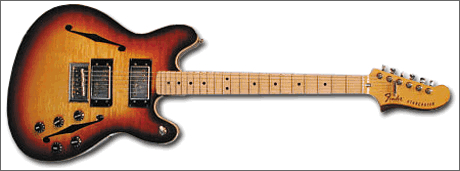
It also had a maple fretboard and an offset twin-cutaway body, somewhere between a Gibson ES-335 and a Fender Stratocaster. The pickups were Fender’s own Wide Range humbuckers, designed by Seth Lover, known for working with Gibson on their original PAF humbuckers, and allegedly naming their iconic Flying V guitar.
The Wide Range pickups were also used on 1970s Telecaster Custom models. This guitar was therefore a bit of a weird compromise between the two major guitar brands at the time.
Because of this fact, the Starcaster was never really accepted by fans of either of the big names. It found few takers, and was discontinued soon after its launch.
However, it has become collectible as a curiosity guitar, and has been used by Dave Keuning of the Killers and Jonny Greenwood of Radiohead. Starcasters rarely come up for sale, so it’s hard to pinpoint prices, but on Ebay they are in the £1200-1500 region.
Neptune Bound: The Ultimate Danelectro Guitar Guide
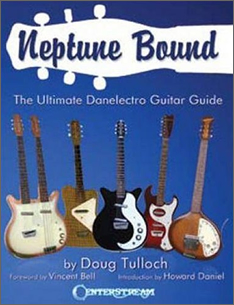
You may have never heard of a Danelectro guitar.
But Jimmy Page and Eric Clapton certainly have.
The unorthodox instruments — known for their unique design and prized for their clear, bell-like tone — belong in the arsenal of every rock guitarist from Aerosmith to ZZ Top.
And with the publication of “Neptune Bound,” Doug Tulloch has established himself as the world’s foremost expert on the classic instrument, a passion that has put him in the company of some of rock’s greatest guitarists.
“Neptune Bound” is a 437-page tome full of all things Danelectro. It is subtitled “The Ultimate Danelectro Guitar Guide.”
The Danelectro was the creation of Nathan Daniel and was produced in America from 1954 to 1969. Danelectros are recognized for their inexpensive but durable construction. Today the American versions begin selling at $300 and can go up to as much as $5,000 if they are celebrity-owned. For the last 10 years, they have been made in Korea.
“The Danelectro is a no-frills instrument,” Tulloch says. “They’re light and comfortable, which makes it a user-friendly guitar.
They were sold out of the Sears catalog which gave young musicians the opportunity to start out with something that didn’t mean spending a lot of money. Over the years they began to get more rare and expensive.
“Chances are that if you grew up in the 1950s or ’60s you knew someone who owned a Danelectro,” Tulloch says. “People reflect fondly on the instruments. They were a decent guitar for the money. They play as well as any other guitar.”
Danelectros are constructed of Masonite around a pine frame with a poplar neck. One of the guitar’s more notable features is pickups that were originally set in lipstick tube casings. And while most modern guitarists will first reach for Fenders or Gibsons, the performance that can be derived from a Danelectro has made it a studio favorite for many players through the years, including Page and Clapton.
In 1991, Tulloch opened City Guitar, an Acushnet Avenue business that dealt in used and vintage guitars, amplifiers and accessories. He was able to build a collection of Danelectros that eventually grew to 150 guitars. His interest in the instrument also allowed him to provide them for rockers such as Joe Perry and Brad Whitford of Aerosmith, Gregg Allman, Dean DeLeo of Stone Temple Pilots and Warren Haynes of Gov’t Mule.
“I started collecting Danelectros when no one else was,” Tulloch points out. “I was selling more popular guitars such as Fenders and Gretsches which allowed me to fund my addiction to Danelectros. Since no one was collecting them when I started, I was able to build my collection for cheap.”
Tulloch closed City Guitar in 1996, but not before establishing himself as the expert source on Danelectros.
“People play Danelectros all across the planet,” he says. “I’ve been in touch with people from Sweden to Singapore. And now this is the book that solidifies the subject. This is the definitive book on Danelectros.”
The book, designed by artist Matt Charros, took three years of persistent dedication. It is being sold in England, Japan, and Australia. It is available in America here:
Neptune Bound: The Ultimate Danelectro Guitar Guide
When Tulloch sells the 200th copy of the book, he’s going to raffle off one of his prized Danelectros — a silvertone amp-in-case model valued at $800.
Today Tulloch still buys and sells guitars as well as doing repair work. He occasionally writes articles for magazines such as Vintage Guitar and Japanese Guitar. The majority of the articles are about Danelectros.
“My life is all about guitars,” he says. “I’ve surrounded myself with my passion.”
By www.southcoasttoday.com
You lucky Californians!
Guitar Center will take its iconic “Legends Collection” on the road beginning May 23 for a 4-city tour that will make weekend stops in Fountain Valley, La Mesa, San Francisco and Hollywood.
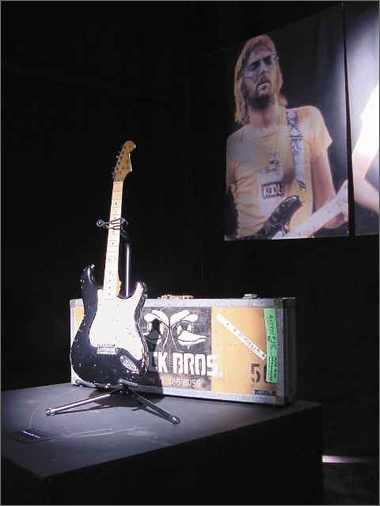 The “Legends Collection” will feature three of rock’s most famous guitars – Eric Clapton’s “Blackie” Fender Stratocaster and Gibson ES-335, as well as Stevie Ray Vaughan’s “Lenny” Fender Stratocaster. Purchased for over $2.4 million from the Clapton Crossroads Centre charity auction at Christies New York in 2004, these three guitars are among the most treasured guitars in rock history.
The “Legends Collection” will feature three of rock’s most famous guitars – Eric Clapton’s “Blackie” Fender Stratocaster and Gibson ES-335, as well as Stevie Ray Vaughan’s “Lenny” Fender Stratocaster. Purchased for over $2.4 million from the Clapton Crossroads Centre charity auction at Christies New York in 2004, these three guitars are among the most treasured guitars in rock history.
Assembled in 1973 by Eric Clapton himself from the parts of several guitars, Clapton played “Blackie” almost exclusively on stage and in the studio from 1973-1985, recording hits such as “Cocaine,” “I Shot The Sherriff,” “Wonderful Tonight,” “Further On Up The Road,” “Lay Down Sally” and various live versions of “Layla” as well as being featured on several album covers and videos. His Cherry Red Gibson “ES-335” was used to record Cream’s versions of “Badge” and “Crossroads” as well as many other historical performances during the 40 years he owned it.
Steve Ray Vaughan’s “Lenny,” which Guitar Center purchased for $623,500, was used to record his classic love songs including “Lenny” and “Riviera Paradise.”
Home to the largest collection of vintage instruments in the nation, Guitar Center is also proud to showcase a hand-picked selection of its most rare and sought-after vintage guitars as part of its Vintage Road Show.
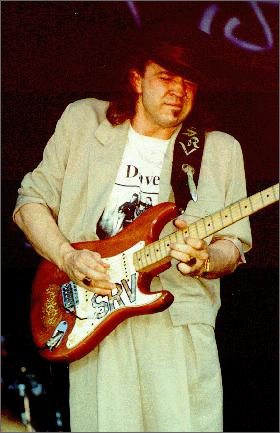
With Vintage locations in Hollywood, Nashville and Manhattan, Guitar Center’s vintage collection includes hundreds of the rarest and most valuable guitars, amplifiers and other instruments, including an impressive assemblage of ’50s and ’60s Strats and Les Pauls, handcrafted archtops, Jazz Basses, P-Basses and more.
Vintage guitar enthusiasts can visit the “Legends Collection” and Vintage Road Show at the following locations:
May 23-24
Guitar Center Fountain Valley
18361 Euclid Street
714-241-9140
May 30-31
Guitar Center La Mesa
8825 Murray Drive
619-668-8400
June 20-21
Guitar Center San Francisco
1645 Van Ness Ave.
415-409-0375
June 26-28
Guitar Center Hollywood
7425 Sunset Blvd
323-874-1060
These are so cool..
Daddy Mojo builds handcrafted guitars from cedar and mahogany cigar boxes.
 The instruments, which are smaller and lighter than standard guitars, sell for between $265 and $735 and have found a following among blues aficionados who can’t get enough of the warm sound they provide.
The instruments, which are smaller and lighter than standard guitars, sell for between $265 and $735 and have found a following among blues aficionados who can’t get enough of the warm sound they provide.
“It has a very unique tone that you can’t find in most other instruments,” said Toronto musician Arthur Renwick, who owns two. “Most people can’t believe just how great it sounds coming from a homemade cigar box.”
The guitars originated as a form of “do-it-yourself” instrument and were used by soldiers during the American Civil War. The practice carried through to the 20th century with poor blues musicians in the Deep South making their own guitars out of discarded cigar boxes and fish wire because they couldn’t afford any other kind.
Daddy Mojo’s present-day incarnation is of better quality than its bare-bones forerunner, but company co-founder Lenny Piroth-Robert says the irony of making an instrument that was born in hard times isn’t lost on him.
“It wouldn’t surprise me if it’s something that makes its mark these days, because it’s really something that came out of a time when people didn’t have much money and had to be creative,” Piroth-Robert said.
“Theoretically the movement would be to make your own (cigar box guitar) in a recession. Mind you, I think we offer a nice, cheaper alternative to most of the guitars out there.”
“(Piroth-Robert) is specifically going against that trend which isn’t about music; it’s about collecting and hoarding and driving the price up.”
Since its inception in 2006, Daddy Mojo has made more than 1,000 cigar box guitars which have been shipped all over the world or sold through retailers in Canada and the United States.
![]()
![]() The Gibson Explorer is a guitar most readers may be familiar with, and it is a well-designed, well-loved shape used by several distinguished rock and metal players. So what in the name of all that is holy (see what I did there?) have they done to this one, many will ask.
The Gibson Explorer is a guitar most readers may be familiar with, and it is a well-designed, well-loved shape used by several distinguished rock and metal players. So what in the name of all that is holy (see what I did there?) have they done to this one, many will ask.
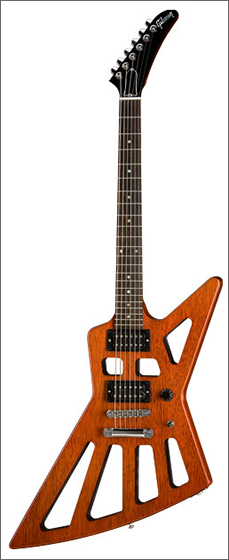 The Holy Explorer is a standard, natural finish Explorer with seven gaping holes cut through the body. There is also a Flying V which has had a similar makeover. The guitars feature the usual attributes of the Flying V and Explorer designs- mahogany bodies and necks, 496R and 500T pickups, and the usual 22-fret rosewood fingerboard. But, those holes…
The Holy Explorer is a standard, natural finish Explorer with seven gaping holes cut through the body. There is also a Flying V which has had a similar makeover. The guitars feature the usual attributes of the Flying V and Explorer designs- mahogany bodies and necks, 496R and 500T pickups, and the usual 22-fret rosewood fingerboard. But, those holes…
The bad sides of the gaping holes would be the obvious deficits in the sustain. Less wood means less vibration can travel through the body, so the notes can’t last as long. Explorers are famed for the colossal sustain of the large body, so this sort of defeats the objective in that sense.
Maybe the pickups make up for it, but I can’t see that happening without use of a Fernandes Sustainer or an E-Bow. As well as that potential problem, the holes probably won’t be to everyone’s taste. I don’t think it looks too bad, I just can’t see the point.
On the other hand, the original Explorer’s considerable weight would be very much reduced, and the design is quite original, although they could have made a better job of the placing of the holes. The classic Explorer’s well proven sustain and feel would inevitably be compromised, but answer me this- the Holy Explorer or that utterly repellent Eye Guitar? Gibson are making a whole run of 2009 Limited Run ultra-low production guitars, which, beside the hideous Tribal V and Explorer, also has some very nicely executed guitars- a reissue of the famed 1970s Grabber bass, and a stunning SG with a carved maple top.
So, the Holy Explorer. I think it’s nicely done, but a bit pointless.
An Explorer with less sustain?
And while the design is neat, it’s far from perfectly executed. And, the price is a bit steep- $2775 against $2399 for the standard Explorer, but it will be a limited run of only 350 guitars, making it quite collectable.  Gibson have gone very much overboard on limited run special editions of late, and it’s wearing a bit thin. We’ve had the slightly overcooked Dark Fire, the new all-maple Raw Power Les Paul and SG, which defeats the objective of those two guitars completely, the  Eye (sore) Guitar, and now the Holy V and Explorer.
Are any of these a match for Gibson’s classic designs such as the Les Paul, SG, ES-335, Firebird, Explorer and Flying V? No. Gibson never used to muck around with expensive and ultimately pointless limited edition models, so why do they feel the need now? They have always stuck to what they’re good at, which has produced some absolutely inspired pieces of guitar design, which is why it’s so infuriating when they don’t do what they’re good at, and play around with decidedly uninspired limited editions such as this.
We need less of this from Gibson, and more inspired designs like the aforementioned classics above.
![]()
![]() The Epiphone Guitar Company of Nashville, Tennessee announces the release of the new limited edition Oh, Pretty Woman 12-string acoustic guitar. Produced in cooperation with the legendary singer/songwriter Roy Orbison’s estate, this signature guitar is based upon Roy’s own 1962 Epiphone ‘Bard’ 12-string acoustic guitar.
The Epiphone Guitar Company of Nashville, Tennessee announces the release of the new limited edition Oh, Pretty Woman 12-string acoustic guitar. Produced in cooperation with the legendary singer/songwriter Roy Orbison’s estate, this signature guitar is based upon Roy’s own 1962 Epiphone ‘Bard’ 12-string acoustic guitar.
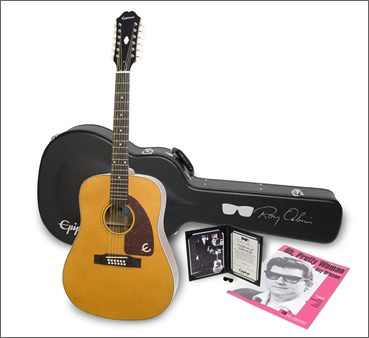 Orbison used his original Epiphone acoustic guitar to write and perform many of his most well-known songs including perhaps his biggest hit Oh, Pretty Woman.
Orbison used his original Epiphone acoustic guitar to write and perform many of his most well-known songs including perhaps his biggest hit Oh, Pretty Woman.
“As a young brilliant guitar player growing up in West Texas, Roy would have never dreamt that he would one day have his own Epiphone signature guitar named after him. Roy wrote Oh, Pretty Woman on his Epiphone 12-string acoustic guitar which features one of the most instantly recognizable rock n’ roll guitar riffs and has remained iconic and fresh to this day.
“I hope the next generation of artists will feel inspired to write another great rock n’ roll song thanks to the Epiphone signature Roy Orbison 12 string acoustic guitar,” said Barbara Orbison, Roy’s widow.
The new Epiphone Oh, Pretty Woman is a faithful reproduction of the 1962 original and features a solid spruce top, a solid mahogany back, a rosewood 12-string bridge and vintage tuners.
For this limited edition release, the back of the guitar’s headstock includes a replica of Roy Orbison’s signature and the notation for the first measure of the world famous Oh, Pretty Woman introduction riff.
Also included in this limited edition offer is a hard case with Roy’s signature and sunglass icon on it, a certificate of authenticity hand-signed by Roy’s widow, Barbara Orbison and Roy’s son, Roy Orbison, Jr., a black & white photo of Roy with his original Epiphone Bard 12-string, a sunglass lapel pin and a copy of the Oh, Pretty Woman sheet music. The certificate and photo come in a leatherette presentation binder.
The Epiphone limited edition Oh, Pretty Woman 12-string Bard outfit will be officially unveiled on Roy’s birthday, 23rd April, at the Gibson Guitar Studio in London, England.
The Roy Orbison limited edition 12-string package has a US MSRP of $1332 and will be available at authorized Epiphone retailers in September 2009.
![]()
![]() The Charvel Spectrum was a Superstrat type guitar made from 1989 to 1991 in a variety of wild colours.
The Charvel Spectrum was a Superstrat type guitar made from 1989 to 1991 in a variety of wild colours.
The series was inspired by a custom model made for Jeff Beck.
The model was a part of Charvel’s Contemporary Series, and was possibly named after the veritable rainbow of bright colours it came in – including bright orange, dark blue, teal and magenta.
For the uninitiated, Superstrat guitars are so named because they take Fender’s classic Stratocaster design and update it, deepening the cutaways, putting in high-output pickups, often adding a Floyd Rose tremolo or one of its derivatives, usually having 24 frets as opposed to the 21 or 22 employed by the Fender.
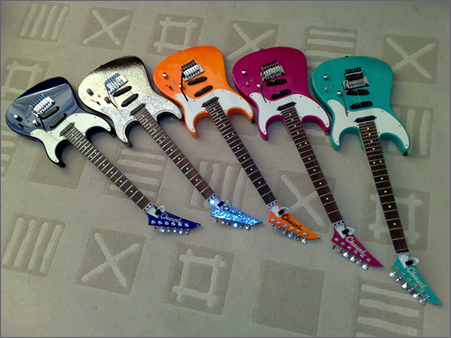
More expensive Superstrats often have neck-through construction and seven-string versions are not uncommon.
This design of guitar is still made by Charvel, adding to the numerous models made by Ibanez, Jackson, BC Rich, ESP and Washburn. The whole genre of guitar was popularized by Eddie Van Halen with his famous “Frankenstrat†guitar.
The Spectrum differed to the usual Superstrat template in various ways, having 22 frets, occasionally a maple fretboard, and a scratchplate based on the old Fender Precision Bass design. They also employed bolt-on construction as opposed to the neck-thru designs of more expensive Charvels. Many sources I have seen state that the body wood is poplar, although there isn’t much concrete info on this.
The neck is maple and the fretboard usually rosewood, although some versions have maple fretboards. The three pickups appear to be single-coils, but are in fact “stacked†single-coil sized humbuckers with an active tone circuit with a wah function.
I have been fortunate to play a couple of examples of this very nice guitar, and I think that any fan of the Superstrat design would like the Spectrum. They are quite collectable now, as not many were made and there are a wide variety of different and unusual finishes.
They don’t tend to command prices out of reach of most players, however.
![]()
![]() The new Gibson Eye guitar has certainly caused a storm of controversy since its recent launch, but mainly for being so damned ugly.
The new Gibson Eye guitar has certainly caused a storm of controversy since its recent launch, but mainly for being so damned ugly.
The limited run, red and white, bastardised SG style guitar has bought a flood of negative comments in blogs and forums for its looks, and it’s not cheap either with a RRP of $2497.
Comments from the Gibson product page include;
“This is the ugliest ******* thing you guys have ever made. Stay off the LSD and start making affortable (sic.) great sounding guitars â€
“Uggggly! With a capital “Uâ€! …and pointeless… â€
“PLEASE….SCRAP THE ENTIRE 2009 LIMITED RUN SERIES before one more innocent tree has to die needlessly. â€
“Hey, Gibson, are you trying to out-do yourselves here? First, the Reverse V, then the Reverse Explorer, then the Holy V and Holy Explorer, and now this? This “Eye†thing, hands-down, is the ugliest thing I’ve ever seen (even more-so than the Pontiac Aztec). It’s not “retro;†it’s not “futuristic;†it’s just plain ugly. Gibson has made some of the most beautiful instruments ever created – the Les Paul, the SJ-200, the Lloyd Loar Mandolins, just to name a few. This new guitar is evidence that Gibson also makes the ugliest instruments. Do yourselves a favor and fire the people that designed this, then fire the people that approved its release. And stop needlessly killing innocent trees… â€
However, I think this guitar has potential.Â
All Gibson guitars have a collectability factor to a certain extent, and this one, like the Gibson Corvus before it, is destined to be quitely consigned to history in a short space of time. A limited run, unpopular and a strong brand name all point to future collectability to me.Â
Assuming dealers will have trouble selling them I predict some nice discounts will be offered, so maybe it would be prudent to pick one up and leave it in the cupboard for a few years. Looking at the values of the Corvus with dealers and on Ebay, surely the Eye will follow along this path of derision, wilderness years, curiosity and finally collectability?
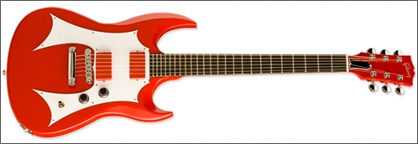
Still not sure I can bring myself to buy one though…
Yamaha is now a huge corporation covering all aspects of musical instruments, and more products including motorbikes. However, in 1976, when the SG2000 was introduced they were very much still an upstart company trying to make a name for themselves.
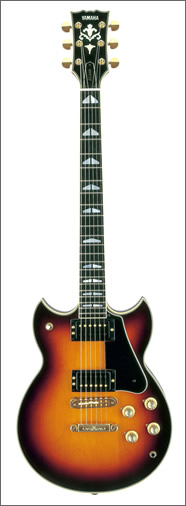
In 1973 they had introduced a range of Gibson inspired SG models- equal cutaway designs with mahogany bodies and set necks- very much like a Gibson Les Paul with two cutaways. They were nice, high-quality guitars, however a classic model was what Yamaha needed to boost this new range, and in 1976 the SG2000 proved to be just what they were so badly in need of.
The SG2000 was thus far the most desirable model Yamaha had ever made. It included a through-neck instead of the set-neck construction used by previous SGs, meaning greater sustain and playability. It was, like the other SG models, met enthusiastically, especially given that the Japanese copy boom was at its peak in around 1976, whereas the SG, while influenced by Gibsons, was still an original enough design.
The SG2000 was based on an earlier Yamaha, the SG175, but had refinements over the original design. These included a contoured body to make playing more comfortable, a maple top, gold hardware and a fine-tuning bridge.
The SG2000 was met well, and became known as a serious alternative to Gibsons of the time. It is still held in high regard as possibly Yamaha’s highest-quality guitar ever, and the one that gave them a serious foothold in the guitar market.
As such many were sold, and they have been used by a handful of well-known artists, the most notable being Carlos Santana, Bill Nelson of Bebop Deluxe and Stuart Adamson of the Skids and Big Country.
The SG2000 is probably the biggest selling model in the SG range, and used examples are not uncommon.
Prices are still high for these desirable guitars, and usually reach between £600 and £1300.
![]()
![]() I’ve just set up a group on facebook which will relate to this website, and will hopefully grow the content more quickly with posts from other readers. Please feel free to join the group, it is open membership, and add your comments, suggestions, photos or anything else you know about old and collectable guitars.
I’ve just set up a group on facebook which will relate to this website, and will hopefully grow the content more quickly with posts from other readers. Please feel free to join the group, it is open membership, and add your comments, suggestions, photos or anything else you know about old and collectable guitars.
![]() A collection of rare British-made electric guitars has been discovered in the basement of a house in Cheltenham.
A collection of rare British-made electric guitars has been discovered in the basement of a house in Cheltenham.
The Supersound instruments came out of a brief partnership between Jim Burns and Alan Wootton during 1958 and 1959.
Guy Mackenzie from West Cornwall, who bought the guitars, described them as “the holy grail” of his collection.
“I don’t actually play,” he said “but I just love them in the same way that people collect old paintings even though they can’t paint.”

Mr Mackenzie heard about the find from a friend who knew he collected “weird and unusual” guitars.
“As soon as I tracked down these ultra-rare instruments – apparently some of the very first made by UK legend Jim Burns – I just had to meet the owner,” he said.
“I discovered he’d bought them from Alan Wootton’s son several years ago and had kept them virtually untouched ever since.”
Jim Burns’ guitars have been played by pop groups and stars including The Shadows, The Searchers, Slade and Queen’s Brian May.
“Musicians who play them now include Andy Bell of Oasis, Franz Ferdinand, Kaiser Chiefs and The Kooks,” said Mr Mackenzie.
Paul Day, guitar expert and author of “The Burns Book” on Jim Burns and his guitars said: “In nearly 50 years of playing, working on and writing about the electric guitar, this is the first time I have actually seen one Supersound instrument, let alone 12.
“These are among the earliest electric guitars and basses from any British builder and therefore comprise an important, but hitherto virtually unknown chapter in UK guitar-making history.”Â
Visit Guy’s website here
from the BBC news website, 15/04/09
Much has been said about the Obama’s gift giving recently. An Ipod for the Queen, the DVDs given to Gordon Brown after his visit to the White House.
 But Michelle Obama may have struck the right chord with her gift to her newest friend, Carla Bruni -Sarkozy.
But Michelle Obama may have struck the right chord with her gift to her newest friend, Carla Bruni -Sarkozy.
After meeting the wife of French President Sarkozy, Mrs. Obama gave Carla Bruni an acoustic Gibson guitar.
Bruni, a former model, is also a singer/songwriter. and on each of her three CD’s, the last of which was released just this past June, she plays the guitar on many of the tracks.
The First lady presented Bruni with the gift  when the ladies visited the Cathedral de Norte Dame de Strasbourg with the rest of the NATO Summit spouses.Â
The two first met the day before when Mr. and Mrs. Obama visited French Palace Rohan. The first lady’s office said that the two women really hit it off and enjoyed a private lunch together that lasted for over an hour together.Â
The guitar is a Gibson “Legends” J-45 Acoustic.
 Gibson has painstakingly reproduced this knockout vintage acoustic down to the minute details. The Gibson J-45 is one of the most played and cherished acoustic guitars in history. This Legends version of the J-45 can handle music from the blues to bluegrass to folk to pop and everything in between. Â Hand crafted by Gibson luthiers using techniques from the J-45 guitar’s heyday, the Legend J-45 boasts an Adirondack spruce top and solid mahogany back and sides to produce unmatched mellow, full-bodied tone.
Gibson has painstakingly reproduced this knockout vintage acoustic down to the minute details. The Gibson J-45 is one of the most played and cherished acoustic guitars in history. This Legends version of the J-45 can handle music from the blues to bluegrass to folk to pop and everything in between. Â Hand crafted by Gibson luthiers using techniques from the J-45 guitar’s heyday, the Legend J-45 boasts an Adirondack spruce top and solid mahogany back and sides to produce unmatched mellow, full-bodied tone.
Did you ever have one of the “what if” conversations? Like, “what if I won the lottery” kind of things. Â Some three years ago the luthiers at Gibson’s acoustic guitar plant in Bozeman, Montana had one of those kind of conversations. It went sort of like this: Â “What if we could go back in time and build a brand new guitar exactly the way they were built back then”.Â
Well, nothing gets the juices flowing like a challenge like that, so the quest was on find the best sounding, original, mint condition Gibson acoustic guitar from the “vintage years,” and build a limited number of guitars today employing the same material, same types of tools, same specs, you name it. The plan was to build a new vintage guitar.
After a long search, a mint, 1942 J-45 was located. Owned by renowned acoustic guitar expert and author Eldon Whitford, the guitar was perfect. It was historically significant, as 1942 was the first year of production for the J-45. The fact that the J-45 is the number one selling acoustic guitar in Gibson’s history didn’t hurt either! Mr. Whitford was kind enough to loan the guitar to Gibson for a painstakingly thorough examination. The guitar went through both X-ray and cat scans  to accurately determine the bracing patterns, wood thickness. The glue and finish were chemically analyzed. To make a long story short, Gibson learned everything about that guitar. The result? The guitar you see here the “Legends Series” 1942 J-45.
![]() The Coronado was a thinline hollow bodied guitar made by Fender from 1966 to 1972. It was designed by former Rickenbacker designer Roger Rossmeisl, who would later design other guitars for Fender.
The Coronado was a thinline hollow bodied guitar made by Fender from 1966 to 1972. It was designed by former Rickenbacker designer Roger Rossmeisl, who would later design other guitars for Fender.
The Coronado came in three models- the Coronado I with only one pickup at the neck, the II with two pickups and the XII, which was a 12 string variant. Pickups used were made by DeArmond.
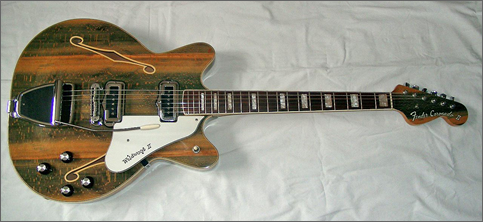 The Coronado II and XII were also available in the desirable “Wildwood†finish, which was an attractively coloured patterned natural grain, made by injecting dyes into growing trees a few years before harvest. There were three shades of Wildwood available on the guitars- Rainbow Green, Rainbow Blue and Rainbow Gold. The bodies were made of maple, and unusually for a semi, the neck was bolted on.
The Coronado II and XII were also available in the desirable “Wildwood†finish, which was an attractively coloured patterned natural grain, made by injecting dyes into growing trees a few years before harvest. There were three shades of Wildwood available on the guitars- Rainbow Green, Rainbow Blue and Rainbow Gold. The bodies were made of maple, and unusually for a semi, the neck was bolted on.
The Coronado was unsuccessful, with the target audience, jazz players, rejecting it for the use of the traditional Fender headstock and the large amount of feedback from the hollow body and single coil pickups.
Traditional Fender players thought the Coronado wasn’t enough of a “real†Fender, and the guitar was a flop.
Examples now sell for upwards of £700 in most places.
You can read about the history of Fender guitars here
![]() Great new hardbound 193 page book about the collectable Swedish Guitars, Hagström
Great new hardbound 193 page book about the collectable Swedish Guitars, Hagström
Superswede: Hagstrom Guitars 50 Years
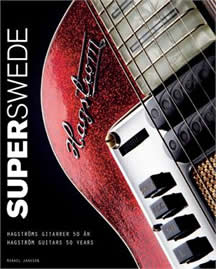 Hagström guitars hold a place in musicians´ hearts. Many of the world´s greatest played Hagström instruments, from ABBA to Zappa. Other international star users are Jimi Hendrix and Elvis Presley.
Hagström guitars hold a place in musicians´ hearts. Many of the world´s greatest played Hagström instruments, from ABBA to Zappa. Other international star users are Jimi Hendrix and Elvis Presley.
Musicians of a younger generation have also discovered these Swedish quality instruments, for example The Cardigans and Sahara Hotnights.
This richly illustrated book – more than 400 photos – displays not only the guitars and basses made in the Älvdalen main factory between 1958 and 1981, but also Hagström instruments sold under other brand names, and instruments built in the Falun and Oslo factories, and by Bjärton.
The close to 200,000 Hagström guitars made are a symbol of Swedish musical, cultural, and industrial history and a fine example of Swedish design.
Author Mikael Jansson is a journalist and musician, and in 2006 published a book (in Swedish) about the Hagstrom company history, “Musik for miljoner”.
![]()
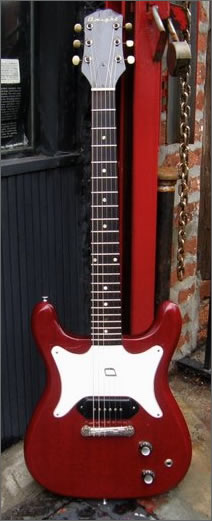 Dwight guitars were made by Epiphone as the house brand for Sonny Shields Music in East St Louis IL, which was owned by Mr Charles “Dwight†Shields.
Dwight guitars were made by Epiphone as the house brand for Sonny Shields Music in East St Louis IL, which was owned by Mr Charles “Dwight†Shields.
Sonny Shields Music was a pretty big music shop back in the 50’s and 60’s and they also had several Dwight guitars made by Supro (and built by Valco), although the most well known was the rebranded Epiphone Coronet, marketed between 1963 and 1968.
The Epiphone built Dwight Coronet model has “Dwight†on the headstock and a “D†in the scratchplate, similar to the “E†in the Epiphone models.
Epiphone guitars of this period were built by Gibson at the Kalamazoo, Michigan, and were distributed by the Chicago Musical Instrument Company (CMI).
An ex-employee of Sonny Shields says that CMI sold the rebranded Dwights to Sonny Shields by the dozen, and that there are probably lots of old Dwights sitting in basements and attics throughout Southwestern Illinois!
These guitars, while rare and unusual are still around and tend to be cheaper that the Epiphone equivalent.
Many Coronets have the 6 on one side headstock as opposed to the 3 per side style of the Dwight, which is stronger in construction, and to my mind, looks better.
Epiphone guitars of this period were generally well made (American Epiphone production ran from 1961 -69) and the Dwights counted among some of the better ones.
These cool looking guitars are well worth picking up if you come across one.
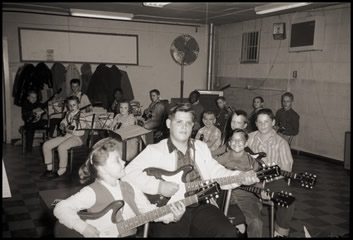
Tens of thousands of dollars worth of vintage, rare and top-of-the-line electric guitars, a $4,200 banjo, ukulele and other musical instruments, CDs and equipment were stolen Saturday or Sunday night from Grampa’s Music, 804-A Anastasia Blvd.
Store owners “Grampa Reece” Smith and his wife, C.J., from St. Augustine Beach, re-organized their remaining inventory Tuesday and worked with customers while also moving instruments into spaces left by the ones stolen.
“It could be worse,” Smith said. “There was no damage done to the store. It’s a shock, but we’re recovering well and will continue with business as usual.”
Three guitars — one of which was a red-orange Gretch owned by the Monkees in 1967 — were each worth in the $5,000 range.
St. Augustine Police reported that the thieves may have entered by opening a locking bolt on the steel back door, which the Smiths found open when they arrived Monday.
Police Officer Walter Makowski reported, “I could not see any signs of a forced entry on the door or steel frame.”
In addition to the inventory, the thieves found $150 and a spare key to a white 1996 Dodge Caravan from behind the counter, loaded the instruments in the van and drove away.
The vehicle, with Grampa’s Music logos on its back windows, is covered by insurance. The inventory isn’t.
A custom guitar builder, Paul Reed Smith, had his first production guitar for sale there on consignment. It, too, was missing. It is labeled “Custom 22” and is wine red.
Grandpa Reece remained optimistic, joking that one of the things that irritated him most was the loss of two expensive dark chocolate bars he left on the counter.
“They came in with a list. They knew what they wanted,” he said. “We’ve had many people come in due to the tough economic times, trying to sell instruments.”
But he said he didn’t want to become like the Big Box stores, suspicious of everybody and watching them all the time.
“We’ll improve security but will continue our mellow and pleasant ways,” he said. “Life goes on. I’m not going to change my attitude.”
The missing instruments include:
* Ome Banjo (bluegrass style)
* Martin D35 guitar, 1971
* Ibanez JEM white, Steve Vai model
* Gibson ES330 Red, 1960s
* Gretch Monkees red-orange guitar, 1967
* Compass Rose tenor ukulele, walnut with maple top
* Fender Stratocaster, Gator orange American Standard 1986
* Brian Moore Electric DC-1, cherry sunburst solid body, 1999
* Paul Reed Smith, Custom 22, wine red
![]()
![]() The Epiphone Wilshire was a solid-body guitar made in the 1960s as an alternative to a Gibson SG. It sported two P-90 pickups and a hardtail bridge, and was put into the Epiphone line in 1960.
The Epiphone Wilshire was a solid-body guitar made in the 1960s as an alternative to a Gibson SG. It sported two P-90 pickups and a hardtail bridge, and was put into the Epiphone line in 1960.
 A long-time sleeper of this Epiphone range, the solid-body Wilshire model represented amazing quality and value throughout the ’60s. Originally intended as something of a rival to Fender’s Stratocaster, offering similar upper-fret access and curvaceous body lines, the Wilshire actually provided similar features and tones to that of Gibson’s own Les Paul Special, at a price closer to that of the more affordable Les Paul Junior.
A long-time sleeper of this Epiphone range, the solid-body Wilshire model represented amazing quality and value throughout the ’60s. Originally intended as something of a rival to Fender’s Stratocaster, offering similar upper-fret access and curvaceous body lines, the Wilshire actually provided similar features and tones to that of Gibson’s own Les Paul Special, at a price closer to that of the more affordable Les Paul Junior.
The Wilshire featured two P-90 pickups, a three-on-a-side headstock, and a solid mahogany body and one-piece neck. It benefited, however, from Gibson’s fully intonable ABR-1 bridge and stop tailpiece, all in all offering a straightforward instrument with up-market features, at a relatively affordable price.
The guitar, like all Epiphone’s solid body guitars, was met with little success and was discontinued in the mid-1960s.
However, there is now a very nice authentic USA-made reissue for a shade under £2000. Unlike most other Epiphones it is not a Far Eastern-made cheaper alternative to a Gibson, but a range-topping American model made in the Gibson Custom Shop.
It is a faithful replica of the 1962 Wilshire model, with the two P-90s, tune-o-matic bridge and classic cherry finish remaining intact.
The bonus features include a certificate of authenticity, a commemorative T-shirt, guitar picks and leather strap. The guitar is close to $5,000 in list price, ironic for a guitar originally sold at $210 and looked upon as a “poor man’s Gibsonâ€.
Gibson have stated that this guitar is limited to only 100 instruments, which will no doubt make it a collectable guitar for the future.
I also saw while browsing around a guitar site, some other Epiphone reissues. This one was a less painstaking reproduction of a Wilshire, looking more like an Epiphone Crestwood in fact, with two mini-humbuckers and an aged finish- however, this one was around £250. I have yet to see it on the official Epiphone website, however, so at the minute I’m not sure.
UPDATE: Gibson have announced a white version, again limited to 100 guitars, and I am assuming at the same price. I have to say it looks even nicer in white…
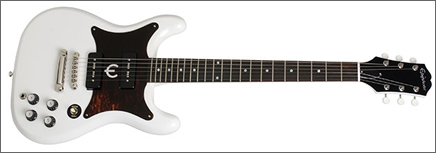
![]() RKS Guitars are an American-based company who make very unusual guitars to bespoke specifications for a high cost.
RKS Guitars are an American-based company who make very unusual guitars to bespoke specifications for a high cost.
The only vaguely conventional feature of these astounding guitars is the silhouette. My first encounter with an RKS was in the High Wycombe shop called BBZ Guitars.
The shape commonly used by the company is an equal cutaway style, made usually of ash. The body has a central part which houses the pickups and bridge, and then there is an external part on each side with a pickup selector between the two pieces.
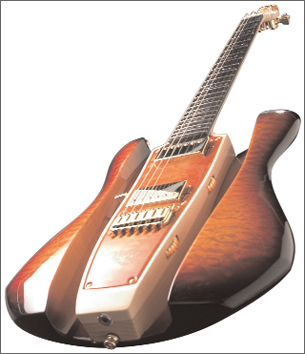 These guitars were designed by Ravi Sahwney, an industrial designer, in conjunction with  Dave Mason, of Traffic and later Fleetwood Mac, and also a renowned solo and session guitarist.
These guitars were designed by Ravi Sahwney, an industrial designer, in conjunction with  Dave Mason, of Traffic and later Fleetwood Mac, and also a renowned solo and session guitarist.
They are known for bespoke craftsmanship, often wild colour schemes, and of course the unique design. Also available is a differently-shaped model, the Wave, built on the same design principle, and the Uluru Boomerang V-shaped model available to custom order.
Prices are usually from £800 or so onwards. Most models retail new for around £1,500. RKS also make basses and baritone models of their guitars.
The neck felt great when we played the RKS, but the shape takes a lot of getting used to, mainly just because of what you traditionally expect, not for any problems playing the instrument.
These guitars are always going to be rare I think, so I would definitely mark them down as a collectable guitar for the future.
I found an interesting book on the Fender Stratocaster, by Tom Wheeler of Guitar Player Magazine.
The Stratocaster Chronicles: Celebrating 50 Years of the Fender Strat
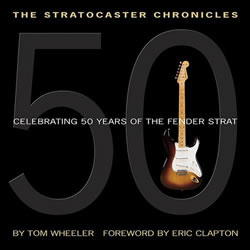
The world’s most famous guitar has a golden anniversary in 2004 and this official, authorised book/CD package offers the best photos, quotes, facts and sounds to properly celebrate this achievement. From Buddy Holly to Jimi Hendrix to today’s hottest players, the Fender Stratocaster defines rock ‘n’ roll for generations of fans and players. A foreword by Eric Clapton. Exclusive photos from the world’s greatest guitar collection. A CD with musical examples of famous Strat sounds and styles – even spoken excerpts from the author’s interviews with the Strat’s beloved inventor, Leo Fender.
And in the words of one Amazon reviewer, “The best Fender Strat book yet”
![]() After my post about the Ovation Breadwinner guitar, I found a couple for sale in London last week.
After my post about the Ovation Breadwinner guitar, I found a couple for sale in London last week.
Both were in the Music Ground shop, and both priced at £899.Â
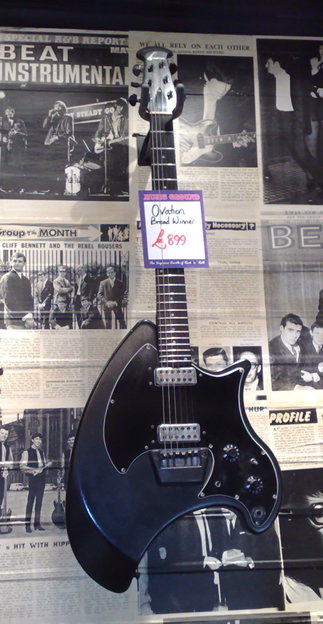 Here is a photo of one of them; it seems to be in pretty good condition and original, but I can’t vouch for that.
Here is a photo of one of them; it seems to be in pretty good condition and original, but I can’t vouch for that.
The shop also had a pair of Hamer Phantoms, one white and one metallic red. Again, these both seemed to be in good condition and were alos both priced at £899.
Music Ground definitely has the most obscure collection of guitars in Denmark Street, everything from old Guyatones, Burns and Ekos through to Arias and Hamers from the 80’s.
I’d recommend a leisurely browse if you are ever in the vicinity!
![]() After my post about the Gibson Les Paul Axcess, I thought I should follow up my mention of the Neal Schon Signature Les Paul. I believe only about 80 of these guitars were made by the Gibson Custom Shop, so they certainly fit under the collectable category.
After my post about the Gibson Les Paul Axcess, I thought I should follow up my mention of the Neal Schon Signature Les Paul. I believe only about 80 of these guitars were made by the Gibson Custom Shop, so they certainly fit under the collectable category.
Here is a video of Neal discussing and demonstrating the Les Paul, and below that is a bit of sales copy about theguitar’s unique features.
Rock guitar icon Neal Schon, best known as Journey’s lead guitarist and famous in his own right, has put his personal touches on the new Neal Schon Signature Les Paul guitar from Gibson Custom. The new model features such personal Schon touches as a Floyd Rose tremolo unit, a dramatically sculpted neck/body joint for easier upper fret access, and a Fernandes Sustainer pickup for the screaming lead parts he is famous for.
The Neal Schon Signature Les Paul model has a carved mahogany top, mahogany back, multi-ply black/white binding on top, chrome-plated hardware and a Floyd Rose tremolo. The one-piece mahogany neck has a scarfed heel joint a “Schon custom†slim-taper neck profile. The 22-fret ebony fingerboard features pearl split-diamond inlays and single-ply white binding. The pickups are a DiMarzio Fast Track/Fernandes Sustainer in the neck position and a Gibson BurstBucker® Pro in the bridge position. In addition to the standard Les Paul electronics (individual pickup volume and tone controls, plus three-way selector switch), the Schon Signature features two mini-toggles – an on/off for the Sustainer and an octave effect – along with a push/pull pot for midrange cut.
![]() Alan Rogan, legendary guitar technician with The Who and the Rolling Stones, talks about his work and guitars. Guitar tech to rock royalty for decades, Alan talks about his long stint with Who guitar legend Pete Townshend, and explains why Pete’s custom-modded Fender Stratocaster® guitar and Vibro-King® amp are “the real thing” …
Alan Rogan, legendary guitar technician with The Who and the Rolling Stones, talks about his work and guitars. Guitar tech to rock royalty for decades, Alan talks about his long stint with Who guitar legend Pete Townshend, and explains why Pete’s custom-modded Fender Stratocaster® guitar and Vibro-King® amp are “the real thing” …

![]() Just a quickie..I found Curtis Novak’s  great site with a wonderful pictorial view of vintage Fender colours.
Just a quickie..I found Curtis Novak’s  great site with a wonderful pictorial view of vintage Fender colours.
Even if you aren’t interested in the colours, it’s worth having a look for the lovely photography.
In Curtis’ own words…
These are pictures of my sample blocks of Fender 60’s colors. I attempted to create as accurate as possible a representation of the colors Fender used in the 60’s. I used Dupont paint and the colors are mixed from the NOS Dupont paint mix numbers. They are cleared with Nitrocellulose Lacquer.
I have photographed my sample blocks in a way that attempts to show the dynamics of a given color rather than just a flat thumbnail image. I feel this better represents the color. I am still working at making the colors more accurate. Keep in mind that I am doing this and testing it on a few dozen different computers and they are rather consistent, but the color may very depending on your display and video card.
![]() Shergold was a little-known guitar company started in 1967 by Jack Golder and Norman Houlder, who had both previously worked for Burns.
Shergold was a little-known guitar company started in 1967 by Jack Golder and Norman Houlder, who had both previously worked for Burns.
They were located in Harold Wood, East London for most of their professional career.
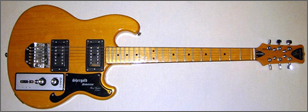
Some models introduced by Shergold were the Masquerader, the Modulator (with active electronics), and the Custom Double, a twin neck guitar available in several different neck combinations. The Masquerader is the best known and most numerous of Shergold’s models, but is still very rare.
Also made was a budget series, the Meteor and Nu Meteor.
Some other models which have been sighted but were made either as prototype models or in very limited runs include the Activator, (suspected to have exceeded no more than 20 units) the Trojan and the Triumph – a rebadged Les Paul style model originally made by Rosetti.
Shergolds were never successful, chiefly because of the weird styling of many of their models, and would be very collectible today as interest grows in unusual old British guitars. I’m not sure how much the different models would be worth, but my guess is at around £500 upwards for a nice one.
![]() “Coco Chanel had an affair with Stravinsky, mine was with a guitar.” Â
“Coco Chanel had an affair with Stravinsky, mine was with a guitar.” Â
Karl Lagerfield
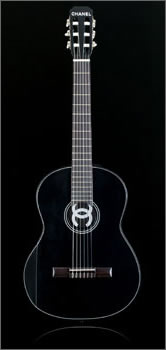
One of the more interesting things seen at the Paris Spring 2009 Fashion shows was the Chanel guitar and guitar bag.
It was a simple black guitar, but it discreetly spells Chanel on the headstock and has the Chanel logo in the soundhole.
It comes with a wide guitar strap in brown, black and white stripe, again with the Chanel logo on the leather detail and a white, quilted leather guitar case.
We’re not sure what the origin of manufacture is, but one notable feature is the unusual forearm contour, (see pic)
So would any real musician buy and use this thing? It will undoubtedly be grossly overpriced, so it seems more like a showpiece than something anyone would actually use, but we may see it turn up in some music videos in the future…
The nylon strung acoustic guitar retails for a mere £2800, including the bag and strap.

![]() Vintage Guitar Gems, an established Vintage/Used Guitar & Amp store in the Conejo Valley was contacted by Yvonne Elliman (EC’s backup singer for many years as well as a songwriter, recording artist and actor) to sell the guitar that was used to record ‘Let it Grow’ during the famous 461 Ocean Blvd recording sessions at Criteria Studios in Florida in 1974.
Vintage Guitar Gems, an established Vintage/Used Guitar & Amp store in the Conejo Valley was contacted by Yvonne Elliman (EC’s backup singer for many years as well as a songwriter, recording artist and actor) to sell the guitar that was used to record ‘Let it Grow’ during the famous 461 Ocean Blvd recording sessions at Criteria Studios in Florida in 1974.
 Mark Lane, the man behind Vintage Guitar Gems is thrilled that Yvonne, a great friend, thought of him and his company when she finally decided to part with this rare beauty.
Mark Lane, the man behind Vintage Guitar Gems is thrilled that Yvonne, a great friend, thought of him and his company when she finally decided to part with this rare beauty.
“I know Yvonne loved and treasured that Martin but her son Ben is starting his dream restaurant with his fine culinary talents and the investment with the proceeds of the Rare Martin sale will jump start Ben’s business and help ‘Let it Grow’ as well.”
Estimates on the final sale price are between $200K & 400K! It is on eBay now and will run for 7 more days.
The Hamer Phantom is a very rare and collectable guitar, built in limited numbers in the 1980s. It started out as a prototype, called simply the Hamer Prototype. It was special in that it had a very unusual three-coil pickup at the bridge. Some also had one single-coil at the neck.

It was based on a good-looking Superstrat shape, with the bass side horn being elongated and the treble-side shortened. It resembled a coupling of a Fender Jaguar and a Jackson Soloist.
The guitars usually had a scratchplate and Kahler tremolo. Some rare models had an ordinary humbucker at the bridge.
All the reviews I have read of this guitar praise it highly, and it is known as a very nice guitar.
One notable Phantom user was/is Andy Summers from The Police.
Phantoms are rare, but surprisingly inexpensive used considering the looks and quality of the build.
I saw two in Denmark Street recently for around £800-900, and I am sure they would sell on eBay for much less, in the rare event of one coming up.
![]()
![]() The Gibson M-III was one of the company’s rare attempts to muscle in on the popular Superstrat movement of the late 1980s, led by Jackson and Ibanez. It was not as successful as other Gibsons and was withdrawn after only a few years in production.
The Gibson M-III was one of the company’s rare attempts to muscle in on the popular Superstrat movement of the late 1980s, led by Jackson and Ibanez. It was not as successful as other Gibsons and was withdrawn after only a few years in production.
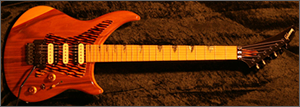 The guitar featured an updated Stratocaster shape with a reverse headstock, and had a set-neck when the trend in Superstrat design was to have a thru-neck, or a bolt-on for the cheaper models.
The guitar featured an updated Stratocaster shape with a reverse headstock, and had a set-neck when the trend in Superstrat design was to have a thru-neck, or a bolt-on for the cheaper models.
All guitars had Floyd Rose style tremolos and two humbuckers plus a central single-coil pickup. Also, where most superstrats had rosewood or ebony fingerboards, the M-III’s frets were set into a slab of maple.
The guitars looked and felt too different from Gibson’s classic models, and are no longer made, although there is an M-III shaped model called the EM-2 in Epiphone’s metal-oriented Prophecy range.
The Gibsons are rare and collectable, but are another example of a 10-20 year-old guitar which offers a lot for not very much money used.
They are worth between £500-800.
I found this video sampler of Paul Brett’s “Paul Brett – Collecting Vintage Acoustic Guitars” DVD…
You can buy the full length DVD from Pauls website, at Fretdancer.com
The Ovation company is best known for its acoustic guitars, although they had a very good crack at the solid electric market in the early 1970s (1972 to be precise) with the UKII, the Preacher, the Viper, and the subjects of this article, the Deacon and Breadwinner.
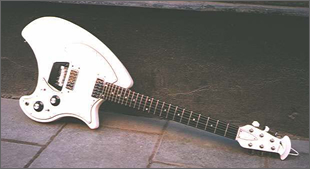 While the former three were fairly normal in design, albeit with traditional Ovation touches in the shapes, the Deacon and Breadwinner seemed almost mutated in comparison, with their bodies shaped somewhat like axes. They also had active mini-humbuckers, rare in the 1970s.
While the former three were fairly normal in design, albeit with traditional Ovation touches in the shapes, the Deacon and Breadwinner seemed almost mutated in comparison, with their bodies shaped somewhat like axes. They also had active mini-humbuckers, rare in the 1970s.
The difference between the Deacon and Breadwinner was not immediately obvious to the casual viewer.
The Breadwinner was the more basic of the two, with dot inlays, no binding on the fingerboard and a larger scratchplate. The Deacon had diamond inlays, binding, a smaller scratchplate, and was only available in natural finishes.
The Breadwinner and Deacon were often seen in the hands of  Jeff Lynne of the Electric Light Orchestra, Steve Marriott and occasionally Ace Frehley of KISS.
On a recent trip to Denmark Street I found a white Breadwinner for sale for around £800.
They are rare and quite collectable even though sales never took off originally.
![]()
![]() We made a road trip this morning to visit the Wembley Guitar Centre in North London, sitting almost in the shadow of the new Wembley Stadium.
We made a road trip this morning to visit the Wembley Guitar Centre in North London, sitting almost in the shadow of the new Wembley Stadium.
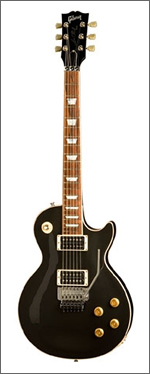 Mark (the manager) and Matt couldn’t have been more friendly and helpful, allowing us to grab whatever guitars we fancied and wailing away with Boogie and Engl amps in their nice  (soundproof!) testing rooms.
Mark (the manager) and Matt couldn’t have been more friendly and helpful, allowing us to grab whatever guitars we fancied and wailing away with Boogie and Engl amps in their nice  (soundproof!) testing rooms.
Wembley Guitar Centre have recently become Gibson dealers and one model that caught our eye was the new custom shop Les Paul Axcess.
This new model has a re-sculpted “heel-less” neck joint, making the upper fret access much more comfortable compared to a regular Les Paul. The other main change is a Floyd Rose tremolo. Considered to be sacrilege in the Les Paul playing community adding a Floyd Rose does widen the appeal and options for new, more metal based players I guess but more traditional Les Paul fans will be knashing their teeth!
The body has also had a “belly cut” added on the rear, and is chambered inside, making it considerably lighter than the other Les Pauls on display.
It sounded great, with two “burstbucker” pickups and the playability was excellent, although I personally I find the painted neck not to my tastes.
These guitars are only (apparently) going to be custom shop models, so will be pretty rare and I am predicting, collectible in the future. I think the ideas for this model have come from the very exclusive Neil Schon custom shop model, which has many of the same features, albeit for an even higher price.
The Axcess isn’t cheap, at £2400 but it may well hold it’s value in the future as an unusual take on a Les Paul.
UPDATE: Now is appears that the Axcess is available without the Floyd Rose, which I assume, will have a lower price point than the tremelo version.
The Wembley Guitar Centre website has the full spec for the guitar here